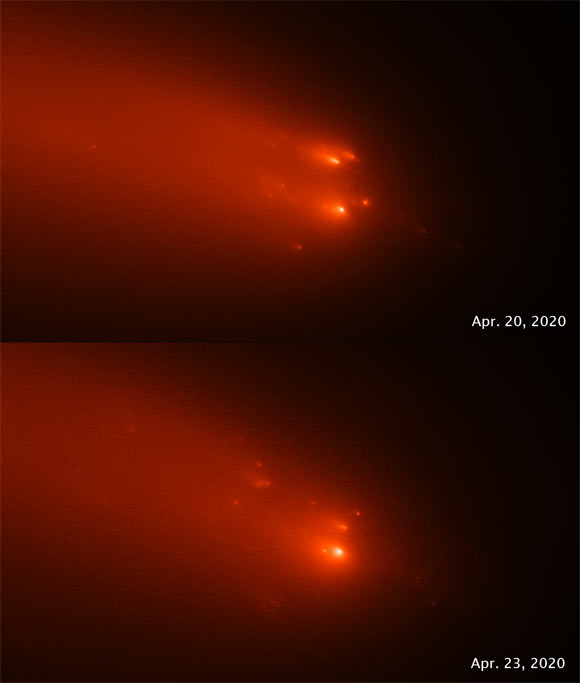The near-Sun comet C/2019 Y4 (ATLAS) is the first member of a long-period comet group observed to disintegrate well before its closest approach to the Sun. Using images obtained by the NASA/ESA Hubble Space Telescope campaign, astronomers have identified two fragment clusters produced by the comet’s disintegration in 2020.

This pair of Hubble images of comet C/2019 Y4 (ATLAS), taken on April 20 and April 23, 2020, reveal the breakup of the solid nucleus of the comet. Image credit: NASA / ESA / Quanzhi Ye, University of Maryland / Alyssa Pagan, STScI.
C/2019 Y4 (ATLAS) was a comet with a near-parabolic orbit and an orbital period of about 6,000 years.
Also known as comet ATLAS, the object was discovered on December 28, 2019 by a reflecting telescope atop Mauna Loa in Hawaii as part of the Asteroid Terrestrial-impact Last Alert System (ATLAS).
At the time of its discovery, the comet was about 3 AU from the Sun and shone at magnitude of 19.6 in the constellation of Ursa Major.
In April 2020, it fragmented just before perihelion, leaving its former tail trailing through space in the form of wispy clouds of dust and charged particles. The disintegration was observed by the NASA/ESA Hubble Space Telescope.
“Comet ATLAS is a broken-off piece of a kilometer-wide ancient visitor from 5,000 years ago,” said Dr. Quanzhi Ye, an astronomer at the University of Maryland.
“Why? Because the comet follows the same orbital ‘railroad track’ as that of a comet seen in 1844.”
“This means the two comets are probably siblings from a parent comet that broke apart many centuries earlier.”
The link between the two comets was first noted by amateur astronomer Maik Meyer.
“Comet ATLAS is just ‘weird.’ Unlike its hypothesized parent comet, ATLAS disintegrated while it was farther from the Sun than Earth, at a distance of over 100 million miles,” Dr. Ye said.
“This was much farther than the distance where its parent passed the Sun. This emphasizes its strangeness.”
“If it broke up this far from the Sun, how did it survive the last passage around the Sun 5,000 years ago? This is the big question.”
“It’s very unusual because we wouldn’t expect it. This is the first time a long-period comet family member was seen breaking up before passing closer to the Sun.”
According to the team, one fragment of comet ATLAS disintegrated in a matter of days, while another piece lasted for weeks.
“This tells us that part of the nucleus was stronger than the other part,” Dr. Ye said.
“One possibility is that streamers of ejected material may have spun up the comet so fast that centrifugal forces tore it apart.”
“An alternative explanation is that it has so-called super-volatile ices that just blew the piece apart like an exploding aerial firework.”
“It is complicated because we start to see these hierarchies and evolution of comet fragmentation. Comet ATLAS’ behavior is interesting but hard to explain.”
The team’s paper was published in the Astronomical Journal.
_____
Quanzhi Ye et al. 2021. Disintegration of Long-period Comet C/2019 Y4 (ATLAS). I. Hubble Space Telescope Observations. AJ 162, 70; doi: 10.3847/1538-3881/abfec3







